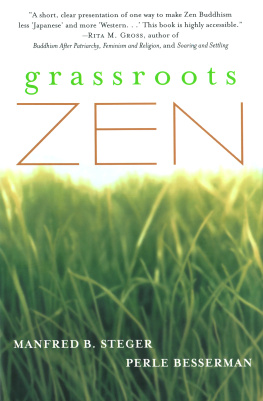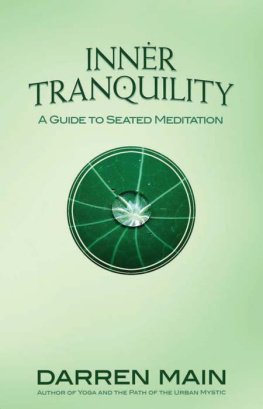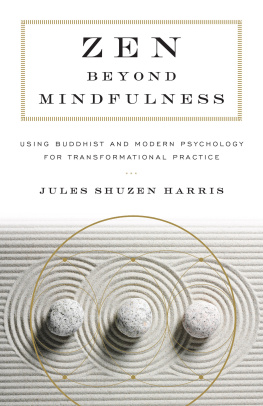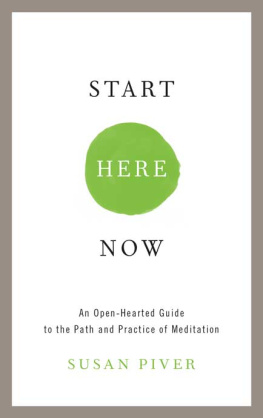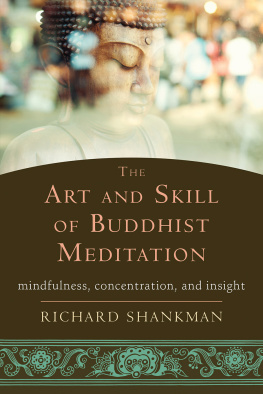ABOUT THE AUTHORS
M ANFRED B. S TEGER received his doctorate in political science from Rutgers University. In 1991, together with his wife, Perle Besserman, he founded the Princeton Area Zen Group, where the two are co-teachers. Before coming to Princeton, Steger was a visiting Zen teacher in Hawaif.Australia, and Europe. In addition to lecturing on Buddhism in the University of Hawaii system in Honolulu and publishing several articles on lay Zen practice in English and German, he and Perle Besserman coauthored Crazy Clouds: Zen Radicals, Rebels, and Reformers (Shambhala, 1991). An associate professor of political science at Illinois State University, Steger is particularly interested in the connection between spirituality and social ethics. His most recent book, on Mahatma Gandhi, is titled Gandhis Dilemma: Nonviolent Principles and Nationalist Power (St. Martins Press, 2000).
P ERLE B ESSERMAN holds a doctorate in comparative literature from Columbia University and teaches in the English department at Illinois State University. Author of numerous books on spiritual subjects, she has become increasingly interested in womens spirituality and leads various workshops and meditation retreats that seek to incorporate womens wisdom into Zen practice. Her most recent books are Owning It: Zen and the Art of Facing Life (Kodansha, 1997), Teachings of the Jewish Mystics (Shambhala, 1998), and The Shambhala Guide to Kabbalah and Jewish Mysticism (Shambhala, 1998).
The authors books have been translated into German, Czech, Portuguese, Spanish, Japanese, Italian, Dutch, and Hebrew.
ACKNOWLEDGENTS
We are grateful to the members of the Princeton Area Zen Group for making this book possible and particularly wish to thank those who generously permitted us to quote them.
For our lively Zen dialogues beyond Princeton, wed like to thank Ursula Baatz, Wolfgang Waas, Jeff Shore, Michelle MacDonald, and Steve Smith.
time


A LL DAY IN GREY RAIN HOLLYHOCKS FOLLOW THE SUNS
INVISIBLE ROAD
B ASH
SO COME, SO GONE
C OMING TO T ERMS WITH C HANGE
In its scant, poignant depictions of the changing seasons, Japanese haiku perfectly captures the nature of our hollyhock journey along the invisible road. Whether appearing as golden sun or as grey rain, the change inherent in passing time is a relentless reminder of our fleeting grassroots existence. We dont know where we came from or where were going, but we never want to stop. We cling for dear life to our little patch of ground, yet the more we cling, the more we suffer. We just cant seem to make peace with changing conditions. Only when we find ourselves out of breath and unable to go on, do we come to a stop. One day it hits us that change is inescapable. Change means theres nothing to hold onto. Change is what brings us to Zen practice.
EVERY BREATH IS DIFFERENT
Nowhere does change become more evident than when we sit on our cushions following the breath. Because we dont usually pay attention to what feels like an automatic process, we fall into the illusion that our breaths are all the same. We think only opera singers and asthmatics have to be aware of breathing. Suddenly we notice that every breath is different, that each inhalation and exhalation is unique and unrepeatable. Broadening our attention, we look at our hearing, touching, seeing, tasting, and smelling and notice that they too are unreplicable. Each step we take, each morsel we taste, each sound we hear is unlike any other. Jolted out of our stupor, we find everything is changing, unfolding from moment to moment. Over and over again, yet always fresh and new, never stale, never routine, we ourselves are coming and going as change.
This isnt a one-time realization. It must be experienced anew every time we sit down on our cushions. We tend to sink back into our old mental habits, so we keep returning to the breath, to this changing moment. We need to allow ourselves to let change happen. Only when we realize that the universe is itself nothing but change, and that its going on all the time, can we begin to experience ourselves as change.
CLOSING THE GAP
Meditation abates the fear of change. It loosens our clutch on the wish for permanence. We no longer take refuge in the idea of an essential soul, an everlasting identity tag thats perfect, unmoving, unchangeable, and therefore real. The self at one with change is more like a drop of water flowing over a rock, changing shape and form as it assumes the face of the rock, perhaps stopping from time to time, until it grows dense and is once again pulled down by gravity into the stream from which it came.
Really allowing yourself to become one with change means you no longer think about change. Instead of separating yourself from changing conditions, emotions, expectations, and goals, you simply disappear into them. Theyre always new. Life is never boring. Having closed the gap between the changing universe, the moment, and the separate entity you think of as your self, you can at last come and go in peace.
PRACTICING THE ART OF CHANGE
Theres a wonderful Pali term for the Buddha, Tathagata. Literally translated, it means so come, so gone. In other words, Buddha is nothing but change. Always present, the Tathagata is continuously manifesting the many things of this world. Nothing is excluded, nothing is separate from this bountiful harvest. Everything is change. When we sit zazen, we practice the art of change, getting a whole new perspective on the passing of time. Instead of fearing change, we can even begin to enjoy our changing conditions. Growing older, letting go of children, reuniting with friends from far awayall these are part of our practice, part of us. We are continuously changing and being changed, living as change. Any condition, no matter how painful or joyful, inevitably gives way to another. But its only by immersing ourselves in the moment that we fully realize this, experiencing over and over again what it is to grow and unfold.
It all begins with the breath. Inhaling this moment, exhaling the next. When you drift away, just bring yourself back. This is whats happening right here. Now. The last breath is gone; heres a new one. A thought comes, fine. Let it pass through. Gone. Back to the breath. Inhale. Exhale. Another thought comes. Okay, too. Let it pass through. The brain generates thoughts in the same way that the liver generates bile. Thats the way the brain works. Thats the brains job. You dont sit and worry about your liver doing what its supposed to do. You dont get angry with it. Apply the same easy acceptance to the function of your brain. Let it send up thoughts. Just dont get carried away by them. Dont get too interested in them. At the same time, allow them to come and go, without monitoring yourself. Eventually, mind and breath become one. This is the quickest entry into discovering yourself as change.
Chinese traditional doctors believe that breath and mind are connected. Those of us whove had acupuncture treatments have experienced this firsthand. As soon as the needles are placed at the meridian points, you simultaneously feel your breath and your thoughts slowing down. The mind actually starts to relax. Thats why so many patients fall asleep. Its even better for patients who meditate; instead of falling asleep, they go into a relaxed but alert state that helps the body attend to healing.
Just breathing. Nothing more. Yet the experience of just sitting and attending to the breath brings us back to the basic fact of our existence. Its not that were illusory. Thats a mistaken idea some people have about Zen practicethat there isnt anyone there at all. You only have to slam your finger in a door to know thats not true. Theres a difference between illusoriness and transience, though. The self, like everything else in the universe, comes and goes, isnt fixed, isnt ever the same from moment to moment. When were hurt, we bleed real blood and cry real tears. But only momentarily. Thats the self being hurt now. In the space of a moment, it will be transformed, become totally new. The self is real, manifesting as the changing moment. The only illusion is that the self is solid, fixed, and that change is somehow assaulting it from the outside.
Next page
